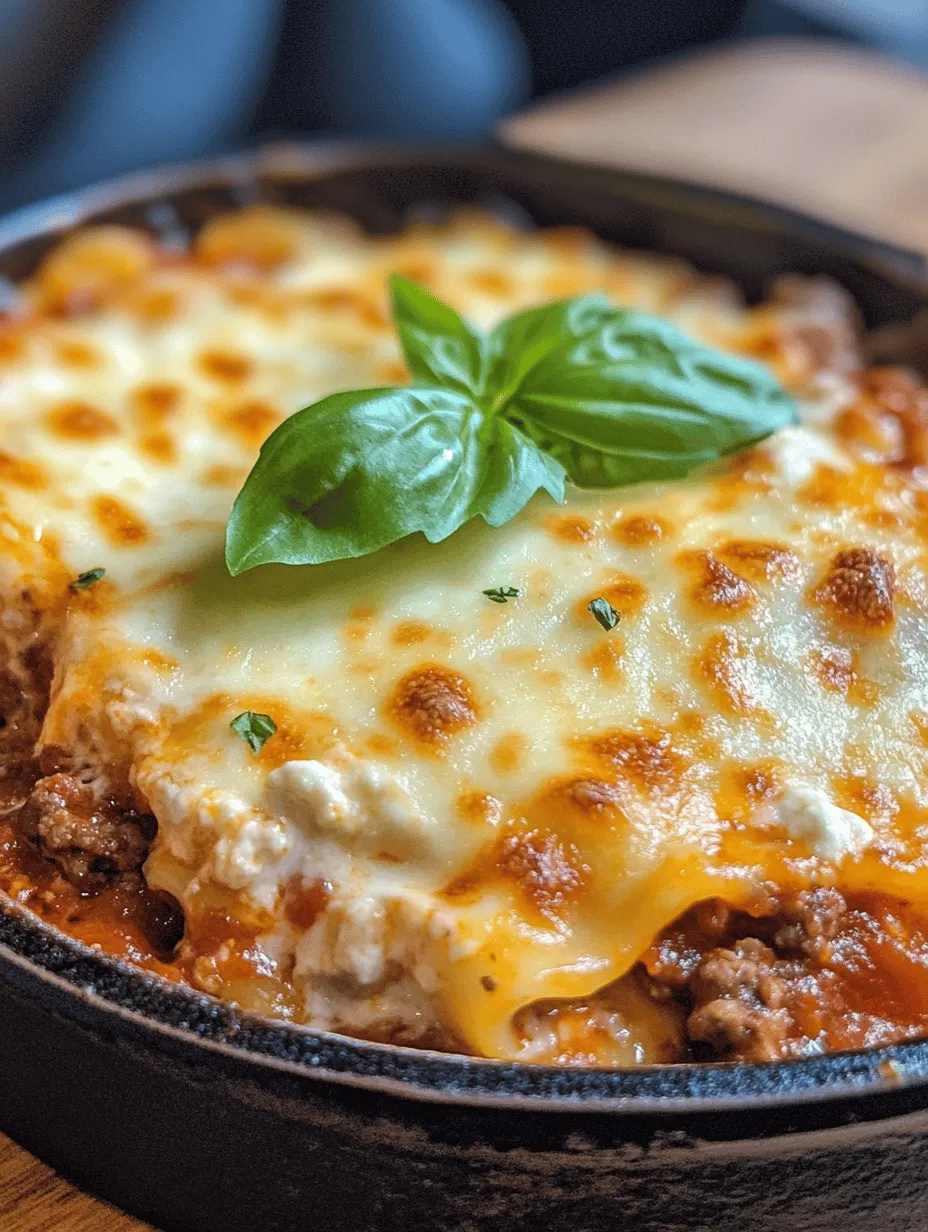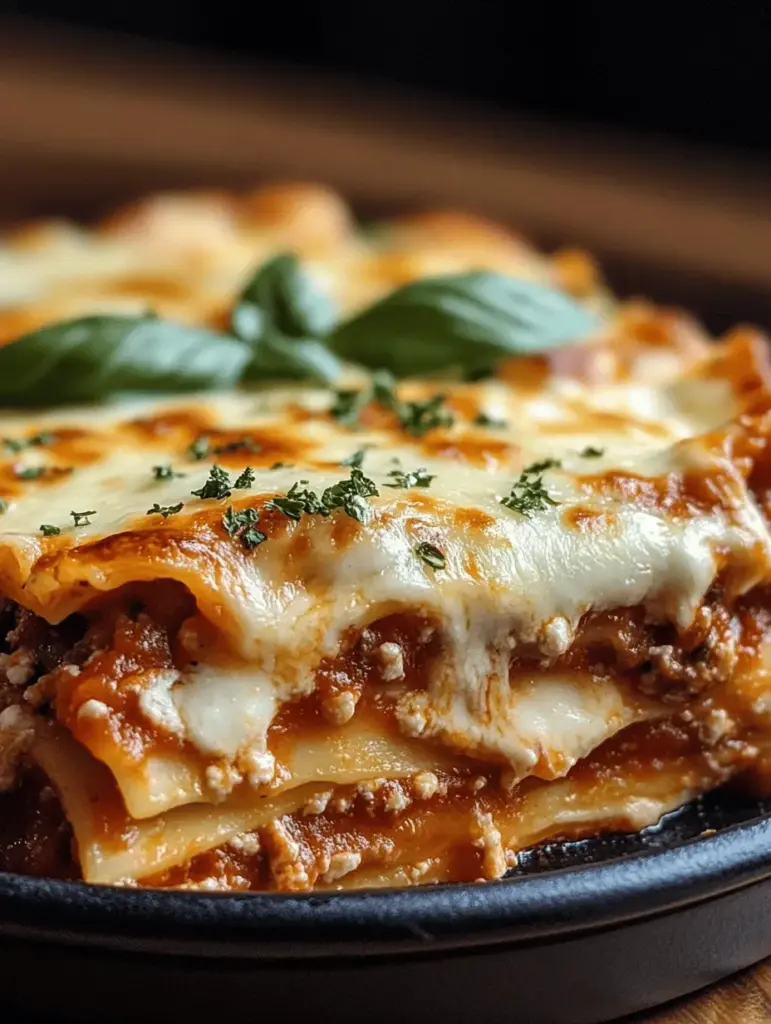Introduction
Lasagna is one of those classic Italian dishes that has transcended borders and become a beloved staple in kitchens around the world. With its layers of rich, flavorful ingredients, lasagna is not just a meal; it’s an experience that brings families and friends together. The comforting aroma that fills the house as it bakes evokes nostalgia, making it a go-to dish for family gatherings, celebrations, or simply a cozy night in.
What makes homemade lasagna particularly special is the satisfaction of crafting it from scratch. Unlike pre-packaged meals, making lasagna allows you to control the ingredients, ensuring freshness and flavor. The process of layering noodles, sauce, and cheese can feel almost therapeutic, allowing you to pour your love into each dish. This easy homemade lasagna recipe aims to simplify the process, making it accessible for even novice cooks while maintaining the traditional essence that makes this dish so cherished.
Understanding Lasagna
Definition and History of Lasagna
Lasagna, at its core, is a dish made by layering sheets of pasta with various fillings, typically including meat, cheese, and tomato sauce. Its origins trace back to ancient Greece, where a dish called “Laganon” was made with layers of pasta and sauce. However, the lasagna we know today evolved in Italy during the Middle Ages, particularly in the region of Emilia-Romagna. The dish gained popularity over the centuries, with numerous variations emerging, each boasting unique regional ingredients and cooking methods.
The Evolution of Lasagna: Traditional vs. Modern Variations
Traditional lasagna features a creamy béchamel sauce, layered with meat ragù and sheets of fresh pasta. However, as culinary preferences evolved, so did lasagna. Modern variations often include ricotta cheese, a variety of sauces, and even vegetarian or gluten-free options. The beauty of lasagna lies in its versatility; you can customize it to suit your tastes, dietary restrictions, or the ingredients you have on hand. Whether you prefer a classic meat lasagna filled with ground beef and marinara sauce or a lighter version packed with roasted vegetables, there’s a lasagna recipe for everyone.
Popularity of Lasagna in Different Cultures
Lasagna has become a universal comfort food, embraced by cultures far beyond its Italian roots. In the United States, it is a staple at potlucks and family dinners, often featuring variations that incorporate local flavors. In Australia, lasagna is similarly adored, with some recipes incorporating bechamel sauce or even a layer of mashed potatoes. The dish has become so ingrained in various culinary traditions that it’s not uncommon to find lasagna served with regional twists, showcasing the flexibility and adaptability of this beloved dish.
Ingredients Breakdown
Creating a delicious homemade lasagna begins with understanding its core ingredients. This recipe will focus on traditional components while allowing room for personal touches.
Overview of Core Ingredients in the Recipe
To make the ultimate homemade lasagna, you’ll need a few essential ingredients. The key components include lasagna noodles, ground meat, marinara sauce, a selection of cheeses, and a blend of herbs and spices. Each ingredient plays a crucial role in building flavor and texture, resulting in a satisfying and hearty dish.
Lasagna Noodles: Types and Their Impact on Texture
The choice of lasagna noodles can significantly affect the final texture of your dish. You can opt for traditional dried lasagna noodles, which require boiling before assembly, or no-boil noodles that soften during baking. No-boil noodles can save time and simplify the process, but some chefs argue that traditional noodles create a more authentic texture. Regardless of your choice, ensuring they are cooked to the right consistency is key to achieving the perfect lasagna.
Ground Meat Options: Beef vs. Italian Sausage
The choice of ground meat can also impact the flavor profile of your lasagna. Ground beef is a classic option that provides a rich, savory taste. However, using Italian sausage can add an extra layer of flavor due to the herbs and spices often included in the sausage mixture. For a lighter option, you can even use ground turkey or chicken. For those seeking a vegetarian alternative, consider using lentils, mushrooms, or a mix of your favorite vegetables to create a delicious meatless version.
Role of Onions and Garlic in Flavor Enhancement
Onions and garlic are foundational ingredients in many Italian dishes, and lasagna is no exception. Sautéing onions until they are translucent brings out their natural sweetness, forming a flavor base for your meat sauce. Adding minced garlic enhances the dish with its aromatic qualities, creating a savory depth that complements the other ingredients beautifully.
Marinara Sauce: Store-Bought vs. Homemade Comparison
The sauce used in lasagna is critical to its overall flavor. While store-bought marinara sauce can save time, making your own sauce from scratch allows for greater control and customization. A homemade marinara sauce can be as simple as simmering tomatoes, garlic, onions, and herbs together until thickened. This approach ensures freshness and allows you to adjust seasoning to your taste. However, if you’re short on time, selecting a high-quality store-bought sauce can still yield a delicious lasagna.
Cheese Varieties: Importance of Ricotta, Mozzarella, and Parmesan
Cheese is where lasagna truly shines, contributing creaminess and richness to the dish. Ricotta cheese is often used in lasagna for its smooth texture and mild flavor, providing a fluffy layer that contrasts beautifully with the meat sauce. Mozzarella, known for its melty goodness, creates that gooey, stretchy layer that everyone loves. Finally, a generous sprinkle of Parmesan cheese on top adds a salty, nutty finish that elevates the entire dish. Feel free to experiment with other cheeses like provolone or fontina for additional flavor dimensions.
Herbs and Spices: Oregano, Basil, Salt, and Pepper’s Significance
Herbs and spices are what bring your lasagna to life. Oregano and basil are classic Italian herbs that complement the tomato sauce and meat perfectly. Fresh herbs can elevate the dish even further, but dried herbs work well too if that’s what you have on hand. Don’t forget to season your layers with salt and pepper, as they enhance the overall flavor and balance the richness of the cheese and meat.
Preparation Steps
With a solid understanding of the ingredients, you are ready to prepare each component of your lasagna. The following steps will guide you through the process, ensuring a delicious outcome.
Detailed Guide on Preparing Each Component of the Lasagna
1. Cooking the Noodles: If you are using traditional lasagna noodles, bring a large pot of salted water to a rolling boil. Add the noodles and cook them according to the package instructions until they are al dente, usually about 8-10 minutes. Remember to stir occasionally to prevent sticking. Once cooked, drain the noodles and lay them flat on a clean kitchen towel to prevent them from sticking together.
2. Browning the Meat: In a large skillet over medium heat, add a drizzle of olive oil. Once hot, add your choice of ground meat. Use a wooden spoon to break it up into smaller pieces as it cooks. Allow it to brown evenly, approximately 5-7 minutes. Drain any excess fat, if necessary, before adding the onions and garlic.
3. Making the Meat Sauce: After browning the meat, add finely chopped onions and minced garlic to the skillet. Sauté until the onions become translucent and fragrant, about 3-4 minutes. Next, stir in your marinara sauce and season with oregano, basil, salt, and pepper. Let the sauce simmer on low heat for about 10-15 minutes, allowing the flavors to meld together beautifully. This step is crucial for developing the rich and savory sauce that will be layered into your lasagna.
Following these initial steps sets the foundation for a delicious lasagna. As you prepare the various components, the aroma in your kitchen will undoubtedly tempt you, building anticipation for the final dish. The subsequent sections will guide you through the assembly and baking process, ensuring your homemade lasagna turns out perfectly every time. Stay tuned for the next part, where we will dive into assembling the lasagna and baking it to golden perfection.

Preparing the Ricotta Mixture: Ensuring Creaminess and Seasoning
The ricotta cheese mixture is essential for achieving that creamy, rich flavor in your homemade lasagna. Start by placing 15 ounces of ricotta cheese in a mixing bowl. To enhance the taste, add 1 large egg and a generous pinch of salt. The egg not only adds flavor but also helps to bind the mixture together, ensuring it doesn’t become too watery during baking. For added flavor, mix in approximately 1/2 cup of grated Parmesan cheese, 1 teaspoon of dried Italian herbs (such as basil, oregano, and thyme), and a dash of black pepper.
Blend the contents thoroughly using a spatula or a fork until you have a smooth, well-combined mixture. The result should be creamy and well-seasoned, perfect for layering within your lasagna. Taste the mixture and adjust the seasoning as needed; you want each layer to burst with flavor.
Layering the Lasagna: Steps to Achieve the Perfect Balance of Flavors
Now that your ricotta mixture is prepared, it’s time to assemble the layers of your lasagna. Begin by preheating your oven to 375°F (190°C). This ensures that your lasagna will bake evenly and develop that golden crust we all love.
1. First Layer: In a 9×13 inch baking dish, spread a thin layer of your meat sauce on the bottom—this helps prevent the noodles from sticking and creates a flavorful base.
2. Noodle Layer: Place three lasagna noodles on top of the sauce, ensuring they do not overlap. If your noodles are the no-boil kind, they will absorb moisture from the sauce as they cook.
3. Ricotta Mixture Layer: Spread half of the ricotta mixture over the noodles, smoothing it out evenly with a spatula.
4. Meat Sauce Layer: Add another layer of meat sauce on top. Use about half of the remaining sauce, distributing it evenly over the ricotta.
5. Cheese Layer: Sprinkle about 1 cup of shredded mozzarella cheese over the meat sauce.
6. Repeat the Layers: Continue this process—noodles, ricotta mixture, meat sauce, and mozzarella—until you have used all your ingredients. Typically, you should end with a final layer of noodles, topped with the remaining meat sauce and a generous sprinkle of mozzarella and Parmesan cheese.
7. Final Touches: To ensure that the top layer doesn’t burn, cover the dish with aluminum foil. This allows the cheese to melt without over-browning.
Baking the Lasagna
Baking your lasagna is a crucial step that allows all the flavors to meld beautifully and the cheese to achieve that gooey, bubbly texture.
Overview of the Baking Process and Its Importance in Texture
Baking is not merely about heating; it’s a transformative process that allows the ingredients to combine. As the lasagna bakes, the noodles soften, the cheese melts, and the flavors intensify. This melding of flavors is what makes homemade lasagna such a beloved dish.
The Significance of Covering and Uncovering During Baking
Initially, cover the lasagna with foil to trap moisture and heat, allowing the noodles to cook thoroughly. After about 30 minutes of baking, remove the foil to allow the top to brown. This uncovered baking is essential for achieving that perfect, golden crust.
Timing and Temperature: Ensuring the Cheese is Bubbly and Golden
Bake your lasagna in the preheated oven for about 45 minutes total. After the first 30 minutes with the foil on, check the lasagna for doneness. You want the cheese to be bubbly and the edges to be slightly toasted. If it’s not done after 45 minutes, continue to bake for additional 5-10 minute intervals until you achieve the desired result. Once baked, allow the lasagna to cool for at least 15 minutes before slicing. This cooling time helps the layers set, making it easier to serve.
Serving Suggestions
When it comes time to enjoy your lasagna, presentation is key. Here are some tips for slicing and serving to elevate your meal.
How to Slice and Serve the Lasagna for Optimal Presentation
Using a sharp knife or a serrated knife, cut the lasagna into squares or rectangles, ensuring you get through all layers without disturbing the structure too much. Using a spatula, carefully lift each piece out of the baking dish and onto a plate. The visual appeal of a well-sliced lasagna is sure to impress your family and guests.
Recommended Side Dishes and Accompaniments
Lasagna pairs beautifully with a variety of side dishes. Consider serving it with a fresh green salad drizzled with a lemon vinaigrette to balance the richness of the lasagna. Garlic bread is another classic accompaniment, perfect for soaking up any leftover sauce. For a heartier meal, roasted vegetables or a simple marinara sauce for dipping can be excellent choices.
Pairing Wines or Beverages with Lasagna for a Complete Meal Experience
When it comes to beverages, a glass of red wine is a traditional pairing with lasagna. Opt for a Chianti or a Sangiovese, both of which complement the tomato sauce and cheese beautifully. If you prefer non-alcoholic options, a sparkling water with lemon or a light Italian soda can provide a refreshing contrast to the richness of the dish.
Storing and Reheating Lasagna
Homemade lasagna often yields leftovers, and knowing how to store and reheat it properly can ensure you enjoy it at its best later.
Best Practices for Storing Leftovers
After enjoying your lasagna, any leftovers should be cooled completely before storing. Place the leftover lasagna in an airtight container or cover the baking dish tightly with plastic wrap or aluminum foil. It can be stored in the refrigerator for up to 3-5 days.
Tips on Reheating Lasagna While Maintaining Texture and Flavor
To reheat lasagna, preheat your oven to 350°F (175°C). Place the slices in a baking dish, cover with foil, and heat for about 25 minutes, or until heated through. If you prefer a crispier top, remove the foil for the last 5-10 minutes of heating. Alternatively, individual servings can be reheated in the microwave for quick meals, though this may result in a slightly softer texture.
Freezing Lasagna: How to Do It Properly for Future Meals
Lasagna freezes exceptionally well, making it a perfect make-ahead meal. To freeze, slice the lasagna into portions and wrap each piece tightly in plastic wrap, then place them in a freezer-safe bag or container. Properly stored, lasagna can be frozen for up to 3 months. To reheat frozen lasagna, it’s best to thaw it in the refrigerator overnight before baking, or you can reheat directly from frozen by increasing the baking time.
Variations and Customizations
Homemade lasagna is versatile, allowing for various adaptations to suit different dietary preferences.
Vegetarian Lasagna Options: Substitutes for Meat
For those looking to make a meatless version, consider using sautéed vegetables such as zucchini, spinach, mushrooms, and bell peppers in place of ground meat. You can also add layers of grilled eggplant or a mix of your favorite seasonal vegetables for added texture and flavor.
Gluten-Free Alternatives for Noodles and Sauces
If you need a gluten-free option, look for gluten-free lasagna noodles available in stores, or you can use thinly sliced vegetables like zucchini or sweet potatoes as substitutes for the pasta. Ensure that your sauce is also gluten-free by checking the labels on the canned tomatoes and any seasonings used.
Creative Twists on Traditional Lasagna: Ingredients to Experiment With
Feel free to get creative with your lasagna! Consider adding layers of pesto for a fresh twist, or using different cheeses like ricotta or goat cheese for a new flavor profile. Incorporating ingredients like smoked mozzarella or even a spicy sausage can elevate your classic lasagna into something extraordinary.
Conclusion
Making homemade lasagna is a rewarding experience that brings joy to both the cook and those who gather around the table to enjoy it. The layers of pasta, rich meat sauce, creamy ricotta, and gooey cheese create a comforting dish that is perfect for family dinners or special occasions.
As you embark on this culinary adventure, take the time to savor the process, from preparing the ingredients to layering the flavors. Homemade meals have a unique way of bringing people together, and your lasagna is sure to be a hit. So gather your loved ones, share a slice of this delicious creation, and enjoy the warmth and love that comes from a homemade meal. Whether you stick to the classic recipe or explore variations, the joy of cooking and sharing homemade lasagna is something to cherish.


